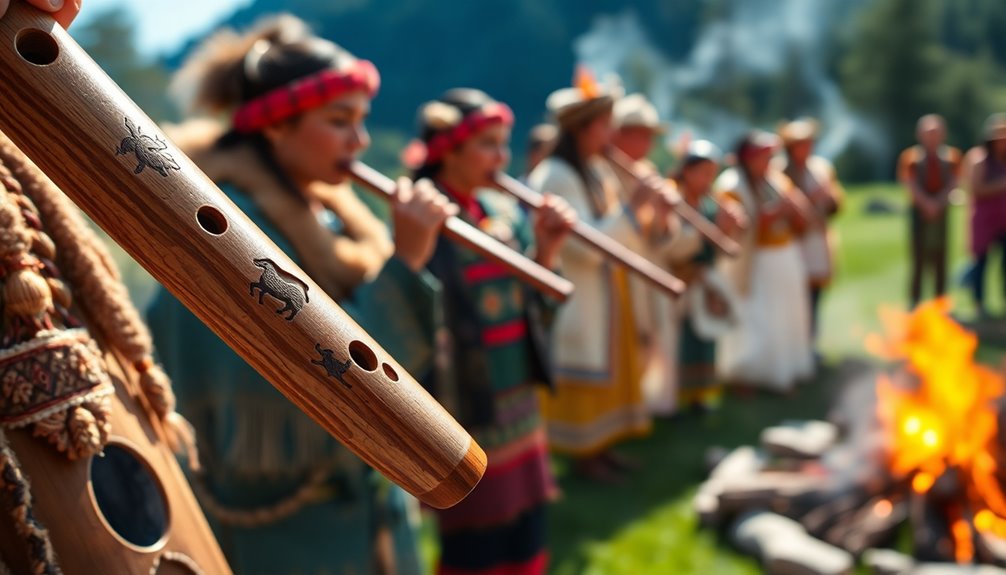Flutes are essential instruments in cultural traditions around the globe, playing key roles in storytelling and spiritual expression. In Asia, bamboo flutes connect communities to their histories. Native American flutes serve as emotional vessels during ceremonies, reinforcing social bonds. European folk traditions showcase flutes that enhance dance and unity, while Africa's flutes weave narratives of identity and heritage. Contemporary uses further evolve this instrument, promoting collaboration and cultural exchange. Each note carries deep meaning, reflecting your unique experiences. Explore how these hidden layers continue to shape and enrich world cultures.
Key Takeaways
- Flutes are integral to cultural storytelling, reflecting historical narratives and community identities across various traditions worldwide.
- In many cultures, flutes serve as spiritual instruments, linking human emotions with nature during ceremonies and rituals.
- The craftsmanship of flutes embodies respect for materials, emphasizing a harmonious relationship with the environment in different cultures.
- Flutes enrich musical diversity, adapting to various styles, from lively folk dances in Europe to deep emotional expressions in African music.
- Contemporary flute ensembles and educational initiatives promote cultural exchange, fostering collaboration and appreciation among diverse populations.
Flutes in Asian Cultures

Flutes have woven themselves into the fabric of Asian cultures, reflecting diverse traditions and beliefs. When you think of bamboo flutes, you might envision serene landscapes where music floats through the air, guiding communal gatherings and spiritual rituals. These instruments aren't just tools for sound; they represent a deep connection to history and identity.
In countries like India and China, bamboo flutes play a vital role in classical performances, where intricate melodies echo the nuances of ancient stories and philosophies. As you explore these musical traditions, you'll notice how flutes foster a sense of belonging. They invite listeners to connect with the culture, bridging gaps between generations.
In many Asian contexts, the act of playing a bamboo flute becomes a communal experience, drawing people together in celebration or reflection. You might find that each note tells a story, embodying the struggles and joys of a community. The craftsmanship of these instruments, often made from aged bamboo(#), significantly enhances their sound quality and cultural value.
Whether in a formal concert or an informal gathering, bamboo flutes resonate with the essence of Asian cultures. They remind us that music is a universal language, one that fosters understanding and appreciation among diverse peoples.
Native American Flute Traditions

Across the Americas, the sound of wooden flutes carries profound cultural significance, particularly within Native American traditions. These flutes serve not just as musical instruments but as vessels of storytelling and spiritual expression. Each note resonates with the rich history and beliefs of various tribes, linking you to their ancestral wisdom.
When you listen to a Native American flute, you're experiencing flute symbolism that conveys emotions ranging from love to sorrow. The flute's voice mimics the sounds of nature, creating a bridge between the human experience and the spiritual domain. You might find that flutes are often played during ceremonies, healing rituals, or community gatherings, reinforcing social bonds and cultural identity.
The craftsmanship of these flutes reflects deep respect for materials and the environment, illustrating a harmonious relationship with nature. As you explore these traditions, you'll discover that each tribe has unique styles and purposes for their flutes—some are used for courtship, while others for meditation or celebration. Additionally, the use of high-quality woods like cedar enhances the warmth of the flute's tone and its overall durability.
Flutes in European Folk Music

Celebrating cultural heritage, flutes have played an essential role in European folk music for centuries. You can hear their enchanting melodies weaving through various traditions, each reflecting a unique story and community.
The flute's versatility allows it to adapt beautifully to different styles, from lively Irish jigs to passionate Spanish flamenco.
Consider how flutes contribute to these rich musical traditions:
- Irish Jigs: Flutes bring a light, airy quality to the rhythm, inviting dancers to join in the exuberance of the celebrations.
- Spanish Flamenco: Here, flutes add a haunting depth, intertwining with guitar and vocals to evoke the raw emotions of the performers.
- Celtic Music: In the Celtic tradition, flutes often feature in sessions, reflecting the communal spirit of storytelling and connection.
- Balkan Folk: The intricate melodies of Balkan music showcase the flute's ability to navigate complex rhythms, bonding listeners through shared cultural experiences.
Additionally, the Western Concert Flute and its rich history provide a foundational element to many of these traditions, showcasing the instrument's evolution and adaptability.
As you explore these musical landscapes, you'll find that the flute isn't just an instrument; it's a vessel for belonging, connecting generations and communities through timeless melodies.
African Flute Practices

In many African cultures, the flute serves as a powerful medium for storytelling and spiritual expression. As you investigate traditional music, you'll notice how the African flute transcends mere sound; it weaves narratives that resonate deeply with communal experiences.
In various regions, flutes crafted from bamboo or wood aren't just instruments but extensions of identity and heritage. The cultural significance of the African flute lies in its ability to connect generations. The concert flute is a widely recognized type of flute that shares similarities with traditional African flutes in terms of its role in musical storytelling.
When you listen to a skilled musician, each note tells a story, reflecting the community's history, struggles, and triumphs. This musical storytelling creates a shared space where listeners feel a sense of belonging, allowing them to engage with the rich tapestry of their culture.
Moreover, the flute often accompanies rituals and celebrations, serving as a bridge between the physical and spiritual domains. In ceremonies, its haunting melodies invoke the presence of ancestors, inviting participants to reflect on their roots.
As you explore these practices, you'll find that the African flute isn't just an instrument; it's an essential vessel of cultural expression, fostering unity and continuity within the community.
Contemporary Uses of Flutes

The evolution of flute music has extended beyond traditional practices, integrating contemporary influences that reshape its role in society. Today, flutes aren't just instruments of cultural heritage; they're vibrant components of modern music. You'll find flutes in various settings, from solo performances to collaborative ensembles, breathing new life into their sound.
Consider these contemporary uses of flutes:
- Modern flute compositions: Composers are experimenting with diverse genres, blending classical, jazz, and electronic music, creating unique soundscapes.
- Urban flute ensembles: These groups are emerging in cities, fostering community and collaboration, while redefining the flute's role in popular music.
- Multimedia performances: Flutists are incorporating visual arts and technology, enhancing the audience's sensory experience and creating immersive environments.
- Educational initiatives: Workshops and outreach programs are promoting flute playing among diverse populations, encouraging cultural exchange and appreciation.
As you explore this modern landscape, you'll discover how flutes continue to connect people, fostering a sense of belonging while adapting to the rhythm of contemporary life. The basic flute for beginners, such as the closed-hole keys, allows new players to develop their technique while participating in these contemporary settings.
Embracing these innovations allows you to witness the flute's enduring relevance in our ever-evolving musical tapestry.
Frequently Asked Questions
How Are Flutes Made in Different Cultures?
You'll find that flutes are crafted using diverse methods across cultures, often reflecting traditional craftsmanship and the unique materials available.
In some regions, artisans carve flutes from bamboo, while others may utilize wood or metal.
Each culture infuses its own techniques, often passed down through generations, making every flute a unique embodiment of its community's identity.
What Are the Symbolic Meanings of Flutes?
You've likely heard that flutes carry deep symbolic meanings across various cultures. This idea holds true, as they often represent a spiritual connection to the universe.
Flutes serve as a storytelling instrument, weaving tales of love, loss, and hope through music. Their melodies evoke emotions, creating a sense of belonging among listeners.
Can Flutes Be Used in Modern Music Genres?
Absolutely, flutes can thrive in modern music genres, bringing a unique sound to various styles.
You'll find flute fusion seamlessly blending into pop, jazz, and even electronic music, creating fresh and innovative melodies.
Contemporary influences have led artists to experiment with flutes, incorporating them into their tracks, which fosters a sense of belonging among diverse audiences.
What Are Some Famous Flute Players Worldwide?
Imagine the flute as a bridge, connecting diverse cultural influences through music.
You'll find famous musicians like Jean-Pierre Rampal, whose melodies resonate globally, and Sir James Galway, known for his virtuosic flair.
These artists not only showcase the flute's versatility but also embody its power to unite people.
Their performances enrich the music scene, drawing you into a world where tradition meets innovation, making you feel part of a vibrant, shared experience.
How Do Flutes Vary in Size and Shape Globally?
Flutes vary widely in size and shape, reflecting diverse cultural influences.
You'll find bamboo flutes in Asia, while silver or wood flutes dominate Western orchestras. Each material affects sound quality, creating unique tones.
Different flute techniques, such as breath control and finger positioning, also adapt to the instrument's design, enhancing expression.
Embracing these variations connects you to a global community that celebrates music's rich tapestry, inviting you to explore and learn more.
Conclusion
Flutes foster fascinating connections across cultures, weaving together the rich tapestry of human expression. From the soulful serenades of Asia to the spirited songs of Native American traditions, flutes not only echo history but also enhance harmony in contemporary contexts. Their versatile voices vibrate through vibrant European folk tunes and African rituals, proving that these simple instruments possess profound power. Embrace the enchanting essence of flutes, and you'll discover a world united through the universal language of music.






